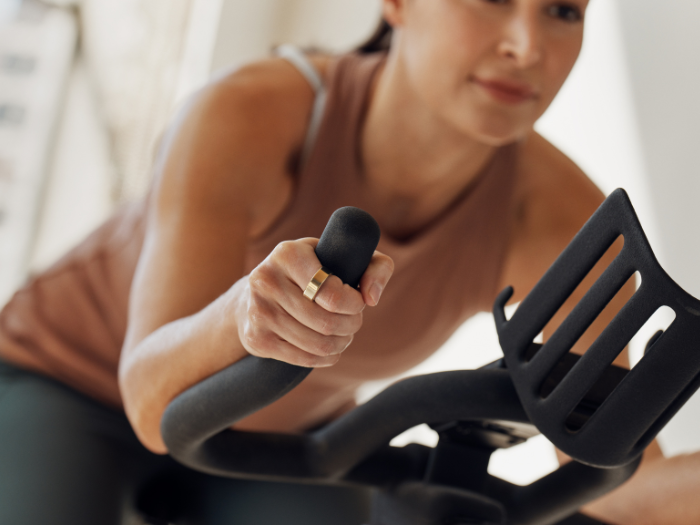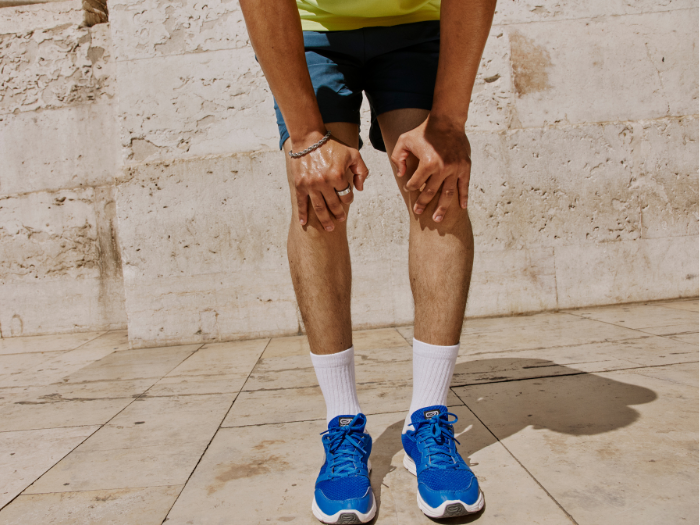A marker for overall cardiovascular health, VO2 max measures how efficiently your body delivers and utilizes oxygen during exercise. This clues you into your body’s capacity for physical endurance and performance.
The greater your body’s ability to supply oxygen to your muscles during sustained physical activity, the higher your VO2 max will be.
Improving your VO2 max is one of the most effective ways to enhance your overall cardiovascular health and fitness—and making some changes to your exercise routine can do just that. By integrating certain types of cardio workouts into your training, you can steadily boost your cardio capacity and your overall health.
| Member tip: Track your VO2 max improvements using the Cardio Capacity feature, which estimates your VO2 max based on a submaximal walking test. Your VO2 max will be categorized in one of four levels: low, fair, high, or peak. |
READ MORE: 8 Ways to Improve Your Cardiovascular Health
Why Does VO2 Max Matter?
VO2 max isn’t just a metric for athletes; it’s a crucial indicator of overall well-being for all individuals. No matter what your health goals are, VO2 max can help you understand if you are getting in better shape, explains Marco Altini, PhD, an Oura data science advisor and exercise physiology expert.
For instance, think about carrying heavy groceries home from the store, going for a hike, or playing with your kids or grandchildren. “All of these activities can require less effort and be more enjoyable with a higher VO2 max,” Altini says.
VO2 max also serves as a strong indicator for overall health, energy levels, and risk of disease. Research shows that a higher VO2 max is associated with a lower risk of future cardiovascular disease, good mental health, improved sleep quality, and a decreased risk of all-cause mortality.
How to Increase VO2 Max
Exercise is the best way to improve your VO2 max. And the good news: Research shows that this metric is highly modifiable through training.
Overall, aim to incorporate a mix of steady-state aerobic exercise with occasional higher-intensity training intervals. As Altini explains, “This combination—keeping your breathing relaxed on most days and pushing harder about once per week—seems ideal to improve VO2 max.”
The specific exercise program you should incorporate, however, depends on your fitness level.
For beginners: Start with low-intensity exercise (e.g., zone 2 training—more on this below). Work up to weekly interval training.
For intermediate or experienced individuals: To level up, your training plan should include low- to moderate-intensity aerobic exercise combined with one to two interval training sessions per week.
| Member tip: Oura now captures your average heart rate and heart rate zones when an activity is automatically tracked or manually added. Once you’ve completed the activity, you’ll see a heart rate chart and how many minutes you spent in each of six heart rate zones. |
Step 1: Add Zone 2 Training to Your Routine
Zone 2 training refers to low-intensity exercise performed in heart rate zone 2, in which your heart rate is about 60-70% of its maximum. This type of movement, which includes activities like jogging, brisk walking, moderate cycling, or hiking, allows your body to efficiently use oxygen for energy.
Figuring out your personal “Zone 2” cardio is crucial, explains Altini. “Beginners typically train at a slower pace or lower power output in this zone,” he says. “Elite athletes, however, can handle more physical work at this same relatively lower intensity.”
Oura’s Automatic Activity Detection feature provides an easy way to find out what level of exercise brings you into Zone 2. Once you’ve completed an activity with Oura, you’ll see a heart rate chart and how many minutes you spent in each of six heart rate zones.
How to Incorporate Zone 2 Training
Each week, aim for two to three 60- to 75-minute Zone 2 cardio sessions, totaling 150 to 200 minutes per week. Consider jogging, brisk walking, hiking, moderate cycling, swimming, rowing, or a vigorous Vinyasa yoga class.
LEARN MORE: All About Heart Rate Zones
How It Works
While zone 2 training may feel easy to some, this type of movement does deliver real benefits to your health. As Altini notes, “All training intensities have benefits, once put in the right context and when aiming for a certain goal.”
“Beginners who train at this intensity will improve their VO2 max as well as their metabolic health,” says Altini. “Advanced and elite athletes can use low-intensity training to accumulate high training loads with less cardiovascular stress and risk of injury.”
In more scientific terms, zone 2 cardio lays the groundwork for aerobic adaptation, mitochondrial development, oxygen delivery, and capillary density. That’s why, regardless of how healthy or advanced in your training you may be, incorporating zone 2 will strengthen your heart and lungs, and set the stage for training-specific improvements to VO2 max.
Step 2: Incorporate Interval Training
Once you establish a solid aerobic foundation with a few weeks of consistent Zone 2 training, add interval training to your routine.
Interval training, often called HIIT (high-intensity interval training), involves alternating between bursts of high-intensity effort (e.g., zones 3 to 5) and periods of lower-intensity recovery.
The best part? You don’t need to do a lot. As little as one interval training session per week provides ample benefits. A 2019 meta-analysis found that the optimal interval training protocol to improve VO2 max included a HIIT workout 1 to 2 times per week for at least four weeks and ideally 12 weeks.
How to Incorporate Interval Training
For beginners: If you’re new to fitness, start slow, Altini advises. While your cardiovascular system adapts quickly, your muscles and tendons need more time to adjust to a new training routine. Gradually increase the intensity to minimize the risk of injury.
But rest assured, putting in the effort will yield results: Research indicates that even low-intensity interval workouts, performed at about 60% of your maximum heart rate (MHR), can improve VO2 max in sedentary individuals.
How to: Aim for one interval training session per week. Perform 20 seconds of high-intensity exercise, followed by 40 seconds of rest (can be stationary or light movement). Repeat 5 times. You can do this on a treadmill, track, rower, or stationary bike.
For intermediate and advanced exercisers:
1. The Norwegian 4 x 4 protocol
Developed by Norwegian researchers, this protocol has been shown to rapidly boost VO2 max. One study showed that overweight individuals improved their VO2 max by 10% in just six weeks using this method.
How to: Perform 4 minutes of high-intensity exercise (85-95% of MHR), followed by 3 minutes of low-intensity recovery (60-70% of MHR). Repeat 4 times.
2. Lactate threshold interval training
Lactate is a byproduct of anaerobic metabolism that builds up in the muscles during intense exercise. When lactate levels rise, it signals the onset of fatigue, limiting your ability to sustain high-intensity efforts.
Lactate threshold training can improve your body’s ability to clear lactate more efficiently, enabling you to maintain higher intensity for longer durations. This training is especially beneficial for athletes with a solid fitness foundation, as it enhances endurance and performance by delaying the point at which lactate accumulation hinders exercise.
How to: Perform 10 minutes of high-intensity exercise (aim for 85-90% of your MHR, also known as your lactate threshold). Rest for 3 minutes, allowing your heart rate to come down through light movement. Repeat 3 to 5 times.
How It Works
Interval training improves VO2 max by making your cardiovascular system more efficient at delivering and utilizing oxygen. It does this by increasing what’s called stroke volume—your heart’s ability to pump more blood with each beat. This allows oxygen-rich blood to reach your muscles more effectively.
Studies show that an 8-week interval training program can boost stroke volume by 10%, leading to lower heart rates at the same exercise intensity. Additionally, high-intensity interval training increases cardiac output, enhancing overall blood flow and oxygen delivery. This, in turn, helps your muscles become more efficient by improving capillary density and mitochondrial function.
Commonly Asked Questions About VO2 Max
Is high-intensity interval training (HIIT) better than moderate-intensity steady-state cardio for improving VO2 max?
HIIT does seem to lead to greater improvements in VO2 max. A study in the European Journal of Preventive Cardiology found that after a 10-week trial with patients who had coronary artery disease, those who did HIIT saw a 17.9% increase in VO2 max, compared to a 7.9% increase in the moderate-intensity group.
However, it also depends on the individual. While HIIT leads to greater VO2 max improvements, it can be physically and mentally demanding, increasing the risk of burnout or injury. Lower-intensity exercise, on the other hand, helps build a strong aerobic base, essential for long-term endurance and cardiovascular health, making it a better option for beginners or those with certain health conditions.
How long does it take to increase VO2 Max?
The time it takes to improve VO2 max depends on your starting point. Most clinical trials show improvements within 6 to 10 weeks of consistent training. if you have a ‘Low’ VO2 max on Oura, you might see changes in just a few weeks. However, if you’re already fit with a moderate or high VO2 max, it could take a few months of following a high-intensity program, such as the Norwegian 4 x 4 protocol, to notice an increase.
About the Oura Expert
Marco Altini, PhD, holds a PhD cum laude in applied machine learning, a M.Sc. cum laude in computer science engineering, and a M.Sc. cum laude in human movement sciences and high-performance coaching. He has published more than 50 papers and patents at the intersection between physiology, health, technology, and human performance. He is co-founder of HRV4Training, advisor at Oura, guest lecturer at VU Amsterdam, and editor for IEEE Pervasive Computing Magazine. He loves running.













